IBG Models 1/72 Fw 190D-14 Prototype (Limited Edition) # 72562
 Spread the cost with Paypal Credit
0% for 24 months available on orders over £199
Spread the cost with Paypal Credit
0% for 24 months available on orders over £199
 Spread the cost with Klarna
0% for 24 months available on orders over £199
Spread the cost with Klarna
0% for 24 months available on orders over £199
![]()
The Fw 190D-14 was a prototype variant of the famed Focke-Wulf Fw 190 series, developed by Nazi Germany during World War II.
The Fw 190, designed by Kurt Tank, was one of the Luftwaffe's most effective fighter aircraft, and the D-series ("Dora") was developed specifically to improve the high-altitude performance of the earlier radial-engine models by introducing a more powerful inline engine.
Fw 190D-14 Overview
The Fw 190D-14 was part of an effort to create a high-performance version of the Fw 190D-series, which was already a significant leap forward from the original Fw 190A.
It followed the successful introduction of the Fw 190D-9, which had proven its superiority in performance, especially at higher altitudes, thanks to the replacement of the radial BMW 801 engine with the more advanced Jumo 213 inline engine.
However, the D-14 was an even more ambitious upgrade.
The Fw 190D-14 was fitted with a more powerful Jumo 213E engine, an improved version of the Jumo 213A engine used in the D-9.
The Jumo 213E was equipped with a two-stage supercharger, designed to enhance the aircraft’s performance at higher altitudes, where air combat with Allied bombers and escort fighters often took place.
Additionally, the D-14 was outfitted with a pressurized cockpit, further emphasizing its role as a high-altitude interceptor.
Key Features and Armament
While the Fw 190D-14 prototype did not reach mass production, its design incorporated several features intended to improve combat effectiveness:
Engine: The prototype was powered by the Jumo 213E inline V12 engine, capable of producing around 1,750 horsepower (2,000 hp with boost systems like MW 50, a methanol-water injection for short bursts of extra power).
Armament: The armament was similar to other Fw 190D variants, with a standard loadout of two 13mm MG 131 machine guns mounted in the cowling, above the engine, and two 20mm MG 151 cannons in the wings. This firepower made the Fw 190D-14 a formidable opponent for both bombers and fighters.
High-Altitude Capabilities: The two-stage supercharger on the Jumo 213E engine significantly enhanced the aircraft’s ability to perform at altitudes above 25,000 feet (7,620 meters), where the Luftwaffe needed effective fighters to intercept Allied bomber formations.
Pressurized Cockpit: This was a unique addition for high-altitude flight, designed to keep the pilot comfortable and capable of performing at extreme altitudes.
Development and Role
The Fw 190D-14 was developed alongside other high-performance variants like the Fw 190D-11 and the Fw 190D-13, with the goal of producing an even faster and more capable interceptor.
The Luftwaffe needed aircraft that could contend with the increasing number of high-altitude American bombers, like the B-17 Flying Fortress, and their escort fighters, such as the P-51 Mustang.
However, despite its promising design, the Fw 190D-14 prototype did not enter full production.
By the time it was developed, Germany’s resources were severely strained, and the production focus shifted to aircraft that were easier to produce and maintain.
Additionally, the impending end of the war in 1945 meant there was limited time for further development of new aircraft types.
Legacy
Although the Fw 190D-14 never saw combat, it represented an important step in the evolution of German fighter aircraft during World War II.
The lessons learned from the D-14 prototype contributed to the development of other high-altitude interceptors, such as the Ta 152, which was also designed by Kurt Tank and shared many design elements with the Fw 190D-series.
In summary, the Fw 190D-14 was an ambitious prototype aimed at creating a high-altitude version of the highly successful Fw 190D.
Though it never reached production, its advanced features like the Jumo 213E engine, two-stage supercharger, and pressurized cockpit highlighted the Luftwaffe's ongoing efforts to maintain aerial superiority late in the war.
| SKU | IBG72562 |
|---|---|
| Manufacturer | IBG Models |
| Scale | 1/72 |
| Short Description | IBG Models 1/72 Fw 190D-14 Prototype (Limited Edition) # 72562 |
-
 IBG Models 1/72 Focke-Wulf Fw-190D-11 Sorau Factory Series # 72533Special Price £20.25 was £22.50 Save 10%
IBG Models 1/72 Focke-Wulf Fw-190D-11 Sorau Factory Series # 72533Special Price £20.25 was £22.50 Save 10% -
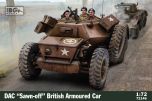 IBG Models 1/72 DAC "Sawn-off" British Armoured Car # 72146Special Price £13.49 was £14.99 Save 10%
IBG Models 1/72 DAC "Sawn-off" British Armoured Car # 72146Special Price £13.49 was £14.99 Save 10% -
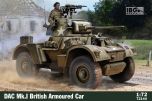 IBG Models 1/72 DAC Mk.I British Armoured Car # 72144Special Price £13.49 was £14.99 Save 10%
IBG Models 1/72 DAC Mk.I British Armoured Car # 72144Special Price £13.49 was £14.99 Save 10% -
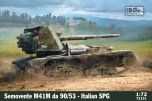 IBG Models 1/72 Semovente M41M da 90/53 - Italian Selfpropelled Gun # 72131Special Price £14.94 was £16.60 Save 10%
IBG Models 1/72 Semovente M41M da 90/53 - Italian Selfpropelled Gun # 72131Special Price £14.94 was £16.60 Save 10% -
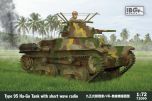 IBG Models 1/72 Type 95 Ha-Go Japanese Tank With Short Wave Radio # 72090Special Price £9.89 was £10.99 Save 10%
IBG Models 1/72 Type 95 Ha-Go Japanese Tank With Short Wave Radio # 72090Special Price £9.89 was £10.99 Save 10% -
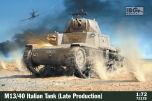 IBG Models 1/72 M13/40 Italian Tank (III Series - Late Production) # 72125Special Price £14.94 was £16.60 Save 10%
IBG Models 1/72 M13/40 Italian Tank (III Series - Late Production) # 72125Special Price £14.94 was £16.60 Save 10% -
 IBG Models 1/72 Scammell Tank Transporter with TRCU30 Trailer and Crusader Mk.I/II (2in1) # 72106Special Price £31.49 was £34.99 Save 10%
IBG Models 1/72 Scammell Tank Transporter with TRCU30 Trailer and Crusader Mk.I/II (2in1) # 72106Special Price £31.49 was £34.99 Save 10% -
 IBG Models 1/72 FV4101 Charioteer British Tank in Finnish Service # 72113Special Price £16.19 was £17.99 Save 10%
IBG Models 1/72 FV4101 Charioteer British Tank in Finnish Service # 72113Special Price £16.19 was £17.99 Save 10% -
 IBG Models 1/72 M11/39 Italian Tank # 72122Special Price £14.94 was £16.60 Save 10%
IBG Models 1/72 M11/39 Italian Tank # 72122Special Price £14.94 was £16.60 Save 10% -
 IBG Models 1/72 90/53 90mm Italian Anti Aircraft Gun # 72159Special Price £12.15 was £13.50 Save 10%
IBG Models 1/72 90/53 90mm Italian Anti Aircraft Gun # 72159Special Price £12.15 was £13.50 Save 10% -
 IBG Models 1/72 I.A.R.80 Romanian Fighter - Gathering Storm 1941 # 72564Special Price £21.24 was £23.60 Save 10%
IBG Models 1/72 I.A.R.80 Romanian Fighter - Gathering Storm 1941 # 72564Special Price £21.24 was £23.60 Save 10% -
 IBG Models 1/72 I.A.R. 81C with Mauser cannons-Great Air battles of 1944 # 72570Special Price £21.24 was £23.60 Save 10%
IBG Models 1/72 I.A.R. 81C with Mauser cannons-Great Air battles of 1944 # 72570Special Price £21.24 was £23.60 Save 10% -
 IBG Models 1/72 Mil Mi-17 in Polish Air Force # 72907Special Price £30.59 was £33.99 Save 10%
IBG Models 1/72 Mil Mi-17 in Polish Air Force # 72907Special Price £30.59 was £33.99 Save 10% -
 IBG Models 1/72 DAC Mk.II British Armoured Car # 72145Special Price £13.49 was £14.99 Save 10%
IBG Models 1/72 DAC Mk.II British Armoured Car # 72145Special Price £13.49 was £14.99 Save 10% -
 IBG Models 1/72 PZL P.11a Hungarian Colours # 72526Special Price £10.98 was £12.20 Save 10%
IBG Models 1/72 PZL P.11a Hungarian Colours # 72526Special Price £10.98 was £12.20 Save 10% -
 IBG Models 1/72 2 in 1: Romanian Barbarossa (PZL P.23A and PZL P.11F in Romanian Service) # 72530Special Price £21.24 was £23.60 Save 10%
IBG Models 1/72 2 in 1: Romanian Barbarossa (PZL P.23A and PZL P.11F in Romanian Service) # 72530Special Price £21.24 was £23.60 Save 10% -
 IBG Models 1/72 Luftwaffe Starter Car And Transport Crate For Engine (Jumo 213 Included) # 72547Special Price £10.80 was £12.00 Save 10%
IBG Models 1/72 Luftwaffe Starter Car And Transport Crate For Engine (Jumo 213 Included) # 72547Special Price £10.80 was £12.00 Save 10% -
 IBG Models 1/72 PZL P.24A/F Fighter in Turkish Service # 72553Special Price £11.43 was £12.70 Save 10%
IBG Models 1/72 PZL P.24A/F Fighter in Turkish Service # 72553Special Price £11.43 was £12.70 Save 10% -
 IBG Models 1/72 Focke-Wulf Fw-190D-11 Sorau Factory Series # 72533Special Price £20.25 was £22.50 Save 10%
IBG Models 1/72 Focke-Wulf Fw-190D-11 Sorau Factory Series # 72533Special Price £20.25 was £22.50 Save 10% -
 IBG Models 1/72 DAC "Sawn-off" British Armoured Car # 72146Special Price £13.49 was £14.99 Save 10%
IBG Models 1/72 DAC "Sawn-off" British Armoured Car # 72146Special Price £13.49 was £14.99 Save 10% -
 IBG Models 1/72 DAC Mk.I British Armoured Car # 72144Special Price £13.49 was £14.99 Save 10%
IBG Models 1/72 DAC Mk.I British Armoured Car # 72144Special Price £13.49 was £14.99 Save 10% -
 IBG Models 1/72 Semovente M41M da 90/53 - Italian Selfpropelled Gun # 72131Special Price £14.94 was £16.60 Save 10%
IBG Models 1/72 Semovente M41M da 90/53 - Italian Selfpropelled Gun # 72131Special Price £14.94 was £16.60 Save 10% -
 IBG Models 1/72 Type 95 Ha-Go Japanese Tank With Short Wave Radio # 72090Special Price £9.89 was £10.99 Save 10%
IBG Models 1/72 Type 95 Ha-Go Japanese Tank With Short Wave Radio # 72090Special Price £9.89 was £10.99 Save 10% -
 IBG Models 1/72 M13/40 Italian Tank (III Series - Late Production) # 72125Special Price £14.94 was £16.60 Save 10%
IBG Models 1/72 M13/40 Italian Tank (III Series - Late Production) # 72125Special Price £14.94 was £16.60 Save 10% -
 IBG Models 1/72 Scammell Tank Transporter with TRCU30 Trailer and Crusader Mk.I/II (2in1) # 72106Special Price £31.49 was £34.99 Save 10%
IBG Models 1/72 Scammell Tank Transporter with TRCU30 Trailer and Crusader Mk.I/II (2in1) # 72106Special Price £31.49 was £34.99 Save 10% -
 IBG Models 1/72 FV4101 Charioteer British Tank in Finnish Service # 72113Special Price £16.19 was £17.99 Save 10%
IBG Models 1/72 FV4101 Charioteer British Tank in Finnish Service # 72113Special Price £16.19 was £17.99 Save 10% -
 IBG Models 1/72 M11/39 Italian Tank # 72122Special Price £14.94 was £16.60 Save 10%
IBG Models 1/72 M11/39 Italian Tank # 72122Special Price £14.94 was £16.60 Save 10% -
 IBG Models 1/72 90/53 90mm Italian Anti Aircraft Gun # 72159Special Price £12.15 was £13.50 Save 10%
IBG Models 1/72 90/53 90mm Italian Anti Aircraft Gun # 72159Special Price £12.15 was £13.50 Save 10% -
 IBG Models 1/72 I.A.R.80 Romanian Fighter - Gathering Storm 1941 # 72564Special Price £21.24 was £23.60 Save 10%
IBG Models 1/72 I.A.R.80 Romanian Fighter - Gathering Storm 1941 # 72564Special Price £21.24 was £23.60 Save 10% -
 IBG Models 1/72 I.A.R. 81C with Mauser cannons-Great Air battles of 1944 # 72570Special Price £21.24 was £23.60 Save 10%
IBG Models 1/72 I.A.R. 81C with Mauser cannons-Great Air battles of 1944 # 72570Special Price £21.24 was £23.60 Save 10% -
 IBG Models 1/72 Mil Mi-17 in Polish Air Force # 72907Special Price £30.59 was £33.99 Save 10%
IBG Models 1/72 Mil Mi-17 in Polish Air Force # 72907Special Price £30.59 was £33.99 Save 10% -
 IBG Models 1/72 DAC Mk.II British Armoured Car # 72145Special Price £13.49 was £14.99 Save 10%
IBG Models 1/72 DAC Mk.II British Armoured Car # 72145Special Price £13.49 was £14.99 Save 10% -
 IBG Models 1/72 PZL P.11a Hungarian Colours # 72526Special Price £10.98 was £12.20 Save 10%
IBG Models 1/72 PZL P.11a Hungarian Colours # 72526Special Price £10.98 was £12.20 Save 10% -
 IBG Models 1/72 2 in 1: Romanian Barbarossa (PZL P.23A and PZL P.11F in Romanian Service) # 72530Special Price £21.24 was £23.60 Save 10%
IBG Models 1/72 2 in 1: Romanian Barbarossa (PZL P.23A and PZL P.11F in Romanian Service) # 72530Special Price £21.24 was £23.60 Save 10% -
 IBG Models 1/72 Luftwaffe Starter Car And Transport Crate For Engine (Jumo 213 Included) # 72547Special Price £10.80 was £12.00 Save 10%
IBG Models 1/72 Luftwaffe Starter Car And Transport Crate For Engine (Jumo 213 Included) # 72547Special Price £10.80 was £12.00 Save 10% -
 IBG Models 1/72 PZL P.24A/F Fighter in Turkish Service # 72553Special Price £11.43 was £12.70 Save 10%
IBG Models 1/72 PZL P.24A/F Fighter in Turkish Service # 72553Special Price £11.43 was £12.70 Save 10% -
 IBG Models 1/72 Focke-Wulf Fw-190D-11 Sorau Factory Series # 72533Special Price £20.25 was £22.50 Save 10%
IBG Models 1/72 Focke-Wulf Fw-190D-11 Sorau Factory Series # 72533Special Price £20.25 was £22.50 Save 10% -
 IBG Models 1/72 DAC "Sawn-off" British Armoured Car # 72146Special Price £13.49 was £14.99 Save 10%
IBG Models 1/72 DAC "Sawn-off" British Armoured Car # 72146Special Price £13.49 was £14.99 Save 10% -
 IBG Models 1/72 DAC Mk.I British Armoured Car # 72144Special Price £13.49 was £14.99 Save 10%
IBG Models 1/72 DAC Mk.I British Armoured Car # 72144Special Price £13.49 was £14.99 Save 10% -
 IBG Models 1/72 Semovente M41M da 90/53 - Italian Selfpropelled Gun # 72131Special Price £14.94 was £16.60 Save 10%
IBG Models 1/72 Semovente M41M da 90/53 - Italian Selfpropelled Gun # 72131Special Price £14.94 was £16.60 Save 10% -
 IBG Models 1/72 Type 95 Ha-Go Japanese Tank With Short Wave Radio # 72090Special Price £9.89 was £10.99 Save 10%
IBG Models 1/72 Type 95 Ha-Go Japanese Tank With Short Wave Radio # 72090Special Price £9.89 was £10.99 Save 10% -
 IBG Models 1/72 M13/40 Italian Tank (III Series - Late Production) # 72125Special Price £14.94 was £16.60 Save 10%
IBG Models 1/72 M13/40 Italian Tank (III Series - Late Production) # 72125Special Price £14.94 was £16.60 Save 10%




























